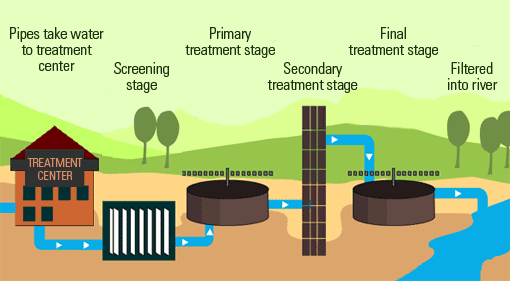Strategic Approaches to Enhance Drainage Treatment Effectiveness and Reduce Ecological Impact
In the world of drainage therapy, the quest for enhanced efficiency and minimized ecological influence is a continuous challenge that demands tactical services. As society comes to grips with the imperative to manage water resources sustainably, a nuanced approach becomes vital. The assimilation of advanced therapy modern technologies, energy-efficient procedures, source recuperation approaches, boosted nutrient elimination strategies, and clever surveillance and control systems stands for a complex structure for attending to these pushing worries. What lies at the core of this facility internet of approaches is the prospective to transform the means we come close to waste water treatment, not just as a procedure of disposal, yet as a beneficial possibility for development and environmental stewardship.
Advanced Therapy Technologies
Innovative membrane layer filtration systems have transformed sophisticated wastewater treatment processes, dramatically boosting the elimination of impurities. This technology has proven to be highly efficient in eliminating a broad variety of pollutants, consisting of drugs, heavy metals, and organic compounds, which are frequently challenging to eliminate via typical therapy approaches.
In addition, membrane layer filtration systems supply many advantages over conventional therapy methods. In addition, these systems are extremely versatile and can be conveniently integrated right into existing treatment plants or made use of as standalone systems for decentralized applications.
Energy-Efficient Procedures
The combination of energy-efficient procedures in wastewater treatment systems is vital for enhancing resource utilization and lowering operational prices. By executing energy-efficient modern technologies, therapy plants can considerably lower their carbon footprint and general environmental effect. One vital technique to boosting power performance in wastewater therapy is the utilization of advanced aeration systems, such as fine bubble diffusers or surface aerators, which can boost oxygen transfer efficiency and minimize power consumption. Furthermore, incorporating power recuperation systems, like anaerobic digestion for biogas production or making use of excess heat for thermal procedures, can help balance out energy needs and advertise sustainability.
In addition, enhancing procedure control and automation with using innovative sensing units and monitoring systems can boost general power effectiveness by readjusting procedures in real-time based upon real need and problems. Applying power audits and routinely keeping an eye on energy performance indications are crucial techniques to identify areas for improvement and track energy-saving initiatives effectively. Overall, the fostering of energy-efficient processes in wastewater therapy not just profits the setting yet also adds to long-lasting expense financial savings and operational sustainability.
Resource Recovery Approaches
With a concentrate on enhancing source utilization and sustainability in wastewater therapy systems, the application of source recovery techniques becomes an essential element in improving functional effectiveness. Source recuperation approaches in wastewater treatment include the recognition and extraction of useful resources from the waste stream, thereby turning what was when considered waste right into a valuable possession. By implementing resource healing strategies such as nutrient elimination and recovery, visit energy generation from raw material, and the production of multiple-use water, wastewater therapy plants can decrease environmental impact while taking full advantage of effectiveness.

Enhanced Nutrient Removal Strategies
Carrying out innovative nutrient removal techniques is crucial for maximizing the effectiveness of wastewater treatment systems. One of the key techniques made use of for enhanced nutrient removal is the process of biological nutrient elimination (BNR), which entails the elimination of nitrogen and phosphorus through biological processes.

In addition to BNR, advanced treatment approaches such as membrane layer bioreactors (MBRs) and created marshes can also be employed to improve site link nutrient removal performance. By integrating these sophisticated nutrient elimination methods right into wastewater therapy systems, towns and sectors can properly minimize nutrient contamination and shield the setting.
Smart Surveillance and Control Solution
Making use of innovative technology, the combination of smart tracking and control systems transforms the functional performance of wastewater treatment centers. These systems integrate advanced sensing units and data analytics to continuously monitor crucial parameters such as pH degrees, turbidity, liquified oxygen, and circulation rates in real-time. By collecting and analyzing this information, drivers can gain valuable insights into the efficiency of the treatment processes, allowing aggressive modifications to optimize therapy efficiency.
Smart monitoring and control systems also support remote surveillance capacities, enabling drivers to accessibility real-time information and control features from off-site locations. This remote availability enhances operational versatility and responsiveness, enabling swift treatments in situation of system malfunctions or changes in influent quality. The predictive maintenance abilities of these systems help prevent equipment failings and decrease downtime, ultimately improving the overall dependability of wastewater treatment operations.
Conclusion
In verdict, calculated strategies such as advanced treatment innovations, energy-efficient procedures, source recovery methods, enhanced nutrient removal strategies, and wise surveillance and control systems play a crucial function in enhancing wastewater therapy efficiency and decreasing environmental impact. By executing these strategies, wastewater therapy plants can improve their overall efficiency, lower power usage, recover important sources, and guarantee conformity with ecological regulations. These techniques are necessary for efficient and lasting wastewater administration methods.

In final thought, calculated approaches such Your Domain Name as innovative therapy technologies, energy-efficient procedures, resource healing methods, improved nutrient elimination methods, and wise monitoring and control systems play a critical role in improving wastewater therapy performance and reducing environmental effect.
Comments on “Enhanced Waste Water Treatment Solutions for Lasting Water Management”